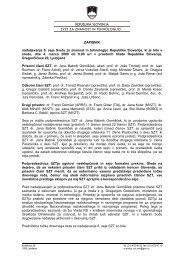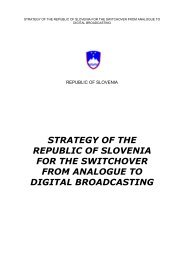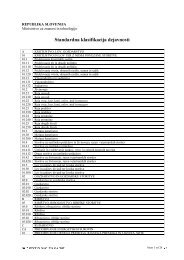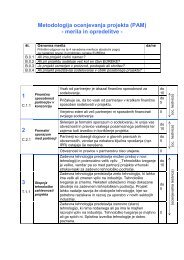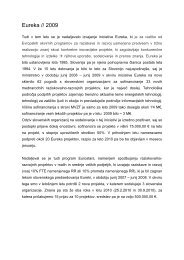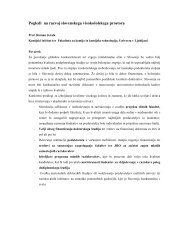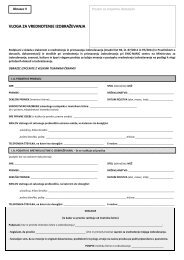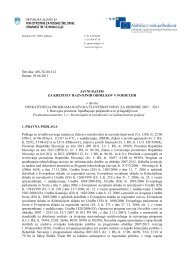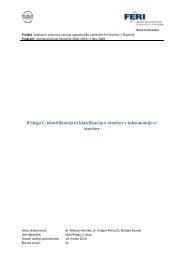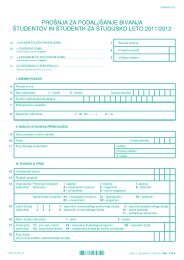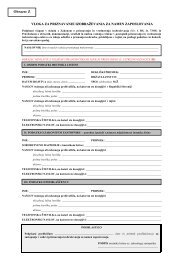Research and Innovation Strategy of Slovenia 2011-2020
Research and Innovation Strategy of Slovenia 2011-2020
Research and Innovation Strategy of Slovenia 2011-2020
- No tags were found...
Create successful ePaper yourself
Turn your PDF publications into a flip-book with our unique Google optimized e-Paper software.
In the process <strong>of</strong> diversification PROs will define their own mission <strong>and</strong> strategy, buildingon the development <strong>of</strong> areas <strong>and</strong> activities where they are or might be particularlysuccessful. All PROs will develop basic knowledge <strong>and</strong> cooperation with users; however,research institutes will focus more strongly on such cooperation than universities.Smaller research institutes which are almost exclusively funded by public resources willbe joined or integrated with the universities based on an in-depth discussion with thestakeholders.3. Establishing an evaluation system <strong>of</strong> PROs’ research activitiesIn order to establish adequate monitoring <strong>of</strong> research <strong>and</strong> innovation system functioning,efficient institutional evaluation is needed that takes into account a wide range <strong>of</strong>measures in establishing definitive findings. The essence <strong>of</strong> institutional evaluation is anindependent external evaluation (foreign <strong>and</strong> national reviewers), which is not basedexclusively on quantitative data. The evaluation system will be developed by the agenciesresponsible for research <strong>and</strong> technological development in cooperation with thecompetent ministries <strong>and</strong> other stakeholders. Evaluation criteria will be based on theevaluation <strong>of</strong> results <strong>and</strong> impact in scientific fields. One set <strong>of</strong> criteria (number <strong>of</strong>publications with high impact factor, citations, research work growth index, cooperationamong PROs, etc.) will be aimed at measuring the scientific excellence <strong>of</strong> the institution<strong>and</strong> international visibility <strong>of</strong> the basic research work. Another set <strong>of</strong> criteria will addresscooperation with the users <strong>and</strong> measuring social relevance <strong>of</strong> the research work. Inaccordance with the mission, the latter will be more prominent in the evaluation <strong>of</strong>research institutes <strong>and</strong> will, among other things, take into account revenues fromlicensing, number <strong>of</strong> patents in patent <strong>of</strong>fices performing a complete test, number <strong>of</strong>spin-<strong>of</strong>f projects from the PRO <strong>and</strong> applicative success <strong>of</strong> the PRO (cooperation with thebusiness sector or projects between PROs <strong>and</strong> users, recruitment <strong>of</strong> students, juniorresearchers <strong>and</strong> researchers in the development departments in the companies, thepercentage <strong>of</strong> research taking place in the priority areas <strong>of</strong> <strong>Slovenia</strong>n TechnologyPlatforms, the percentage <strong>of</strong> research to support projects <strong>of</strong> social interest, <strong>and</strong> others).4. Autonomy <strong>and</strong> responsibility <strong>of</strong> PROs to enable their strategic development inaccordance with national prioritiesWith gradually increasing institutional funding due to reduced/terminated programmefunding, we will ensure greater autonomy <strong>and</strong> responsibility in preparing the strategy forhuman resources management <strong>and</strong> development/programme strategy to PROs. R&Dactivity has to take place within a partnership in which a PRO assumes responsibility forthe employees <strong>and</strong> for different social environments, i.e. all its system components <strong>and</strong>for society as a whole.Institutional funding <strong>of</strong> R&D activity <strong>of</strong> the higher education sector <strong>and</strong> institutes will beharmonised <strong>and</strong> will include two pillars: one fundamental, the other development. Thefundamental pillar will provide stable funding <strong>of</strong> R&D activity <strong>of</strong> PROs, <strong>and</strong> thedevelopment pillar will provide additional funding depending on fulfilment <strong>of</strong> the mission<strong>of</strong> institutions <strong>and</strong> achievement <strong>of</strong> preset objectives <strong>and</strong> will be based on the results <strong>of</strong>the evaluation <strong>of</strong> PROs.A modified method <strong>of</strong> funding PROs will allow the achievement <strong>of</strong> objectives <strong>of</strong> the RISSwhile respecting their autonomy to organise their own institutional strategies <strong>and</strong> ways inwhich to fulfil the set objectives. Public funding mechanisms will be designed to allowmore independent decision-making by PROs on use <strong>and</strong> integrated management <strong>of</strong>resources earmarked for institutional funding.In addition to the transition to institutional funding <strong>of</strong> institutions regarding stablefunding, the existing project funding <strong>of</strong> research work through the "research hour" unitwill be replaced by (co)funding the actual costs <strong>of</strong> projects.Institutions will gain greater autonomy in recruiting <strong>and</strong> managing human resources,since researchers <strong>of</strong> a particular institution will be able to withdraw from the salarysystem due to the agreement between those involved. We expect <strong>and</strong> we wish that themanagement <strong>and</strong> employees <strong>of</strong> research institutions will make a common proposal as tohow to regulate the salary system <strong>and</strong> the rights <strong>and</strong> duties <strong>of</strong> the employees, with one



